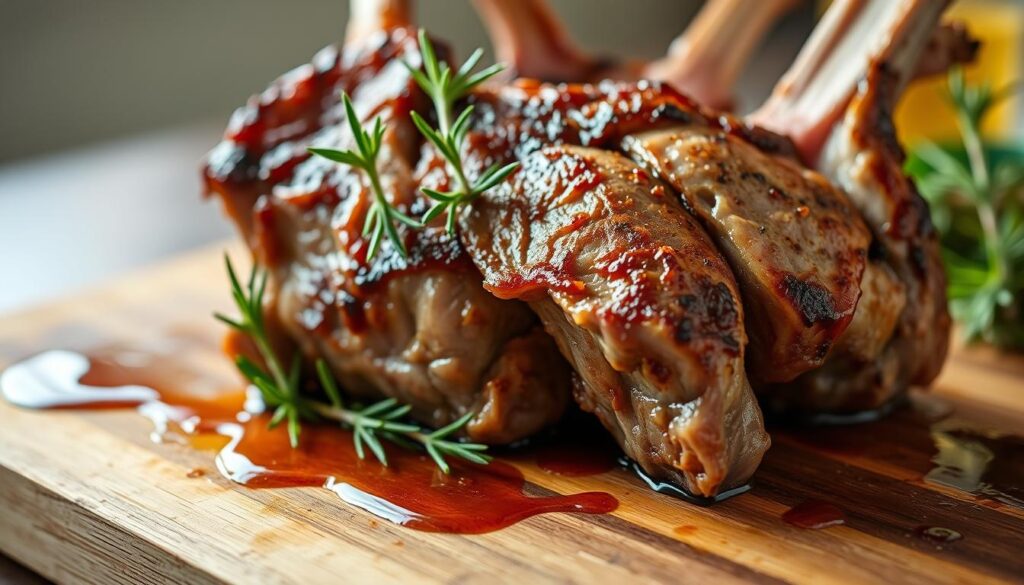BEST Juicy Roasted -1-Rack of Lamb Recipe
Looking for a show-stopping dish that impresses without the fuss? A perfectly cooked rack of lamb delivers elegance and flavor in every bite. This recipe turns a special cut into a restaurant-worthy meal in just 25 minutes.
The magic lies in simple ingredients like garlic, rosemary, and Dijon mustard. As one home cook raved, "SO DELICIOUS! The 450°F oven temp creates a perfect crust, and resting 15-20 minutes makes it incredibly juicy."
Whether hosting holidays or an intimate dinner, this dish adapts beautifully. The golden exterior and tender interior guarantee compliments. Best of all, the technique is straightforward enough for any skill level.
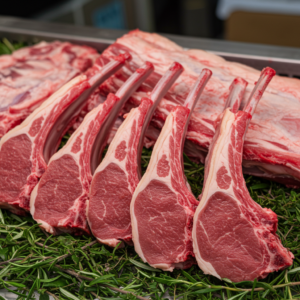
Key Takeaways
- Elegant centerpiece for special occasions
- Ready in just 25 minutes active time
- Uses simple, flavorful ingredients
- Resting ensures maximum juiciness
- Works for both large gatherings and small dinners
Why Rack of Lamb?
Few dishes balance elegance and simplicity like this one. Two 2-pound racks feed 6–8 people, making it ideal for gatherings. Unlike slow-cooked roasts, it reaches medium-rare perfection in just 25 minutes—perfect for busy hosts.
This cut competes with prime rib or tenderloin but offers richer taste. The ribs are often "frenched" (trimmed for looks), though *some fat adds flavor*. Aim for 130°F internal temp before resting—this keeps it juicy.
| Type |
Size |
Fat Content |
Flavor |
| American |
Larger |
Moderate |
Mild |
| Imported |
Smaller |
Higher |
Bolder |
Apartment cooks love it for oven efficiency. If worried about gaminess, try garlic-herb rubs or mustard marinades. They enhance the meat’s natural richness without overpowering.
Ingredients for Roasted Rack of Lamb
Simple, quality components make all the difference in this dish. Fresh herbs, robust garlic, and rich olive oil create a crust that’s crispy outside and tender inside. Here’s what you’ll need:
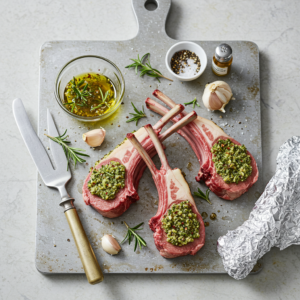
For the Herb Crust
Fresh rosemary beats dried for vibrant flavor. Use 6 sprigs, finely chopped. Combine with 6 garlic cloves (minced) and 3 tablespoons olive oil for a fragrant paste.
Dijon mustard isn’t just for tang—it helps the crust stick. Add 2 tablespoons and a pinch of red pepper flakes for heat. Prefer Mediterranean? Boost garlic to 10-12 cloves.
For the Lamb
Kosher salt preps the meat evenly, while flaky salt adds crunch after cooking. Use 1 teaspoon kosher salt and freshly ground pepper to taste.
Pro tip: For international cooks, 3 tablespoons olive oil equals 45ml, and 2 tablespoons Dijon is 30ml.
How to Prepare
A few simple prep steps elevate this dish from good to extraordinary. Proper handling ensures even cooking and deep flavor. Follow these techniques to make the most of your ingredients.

Trimming and Frenching (Optional)
Start by trimming excess fat for a crispier crust. Use a sharp chef’s knife to remove thick layers, leaving a thin coating for moisture. *Save trimmings for stocks or sauces.*
For a polished look, french the bones:
- Score meat between ribs with a paring knife.
- Scrape downward to expose 1–2 inches of bone.
- Wrap exposed bones in foil before roasting to prevent charring.
Tip:Skip frenching if you prefer richer taste—thefatcap adds flavor during cooking.
Marinating for Maximum Flavor
Combine herbs, garlic, and oil in a food processor for a quick paste. Rub it over the racks, coating evenly. Marinate at room temperature for 1 hour or refrigerate overnight.
Key timing options:
- 30 minutes: Quick flavor boost for busy cooks.
- 12 hours: Deeper infusion for intense taste.
Always let chilled meat sit out for 20minutesbefore roasting. This prevents uneven cooking.
Cooking
Mastering the cooking process transforms this premium cut into a succulent masterpiece. The right balance of heat and timing ensures a crispy exterior and juicy center. Follow these steps for flawless results.
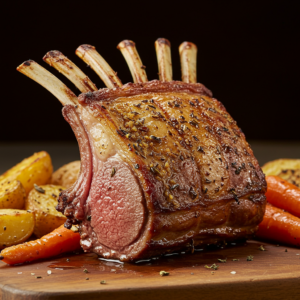
Searing vs. Roasting
Searing in a cast iron skillet before roasting locks in juices. Heat the pan until smoking, then brown the fat cap for 2–3 minutes. Alternatively, pure roasting at 450°F delivers even cooking without extra steps.
Tip: Bone-side down positioning prevents uneven browning. The ribs act as a natural rack for airflow.
Oven Temperature and Timing
Preheat your oven to 450°F with a rack in the top third. Roast for 15 minutes per side for medium-rare. Smaller cuts may need 12–14 minutes.
Carryover cooking raises the internal temperature by 5°F during resting. Pull the meat at 125°F for rare or 130°F for medium.
Checking Internal Temperature
Insert a thermometer into the thickest part, avoiding bones. Accuracy matters—undercooked meat lacks flavor, while overcooked turns tough.
| Doneness |
Internal Temp (°F) |
Rest Time |
| Rare |
125 |
10 mins |
| Medium-Rare |
130 |
12 mins |
| Medium |
135 |
15 mins |
"The high heat method gave me a perfect crust without drying out the center. Game-changer!"
Looking for a show-stopping dish that impresses without the fuss? A perfectly cookedrack of lambdelivers elegance and flavor in every bite. This recipe turns a special cut into a restaurant-worthy meal in just 25 minutes.
The magic lies in simple ingredients like garlic, rosemary, and Dijon mustard. As one home cook raved, "SO DELICIOUS! The 450°F oven temp creates a perfect crust, and resting 15-20 minutes makes it incredibly juicy."
Whether hosting holidays or an intimate dinner, this dish adapts beautifully. The golden exterior and tender interior guarantee compliments. Best of all, the technique is straightforward enough for any skill level.
Key Takeaways
- Elegant centerpiece for special occasions
- Ready in just 25 minutes active time
- Uses simple, flavorful ingredients
- Resting ensures maximum juiciness
- Works for both large gatherings and small dinners
Resting and Carving
The final steps make all the difference between good and exceptional results. Let the meat rest for 10–20 minutes after roasting. This allows juices to redistribute, ensuring every bite stays succulent.
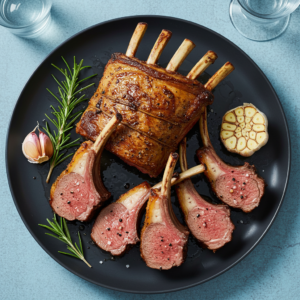
Tent the lamb loosely with foil to retain heat without steaming the crust. For frenched racks, slice between each rib to create individual chops. Angle the knife slightly for cleaner cuts.
Save pan drippings for sauces—simply deglaze with wine or broth. Avoid pressing down while carving; this squeezes out precious juices.
Pro tip: Wipe the knife between slices to keep presentation neat. If the fat cap is thick, trim it post-resting for better texture.
Serving Suggestions
Transform your meal into a gourmet experience with perfect pairings. The right accompaniments highlight the dish’s richness while adding texture and contrast. Below, find timeless combos and creative twists to suit any occasion.

Classic Pairings
Tzatziki and Greek potatoes are crowd-pleasers. The cool yogurt sauce cuts through the meat’s richness, while crispy potatoes roasted with garlic and rosemary add crunch. For wine, opt for a bold red like Cabernet Sauvignon or a fruity Pinot Noir.
Pro tip: Trader Joe’s Dijon mustard makes a quick glaze when mixed with honey.
| Wine Type |
Pairing Note |
| Cabernet Sauvignon |
Balances robust flavors |
| Pinot Noir |
Enhances herbal notes |
| Rosé |
Lightens heavy dishes |
Elevated Sides
Seasonal vegetables like asparagus or roasted carrots add color. Toss them in olive oil and sea salt for simplicity. For gluten-free options, try quinoa pilaf with toasted almonds.
Leftovers? Chop meat for salads or fold into flatbreads with hummus. Presentation matters: Arrange chops on a platter with herb sprigs and lemon wedges for visual appeal.
Recipe Variations and Tips
Customize your meal with creative twists that suit any taste. Small changes to ingredients or timing can transform this dish into a new experience every time.
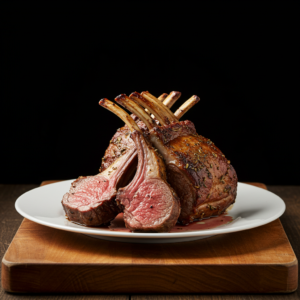
Herb Swaps
Fresh thyme or parsley works instead of rosemary. For Mediterranean flair, add oregano and lemon zest. Pro tip: Crush dried herbs to release more flavor.
Whole grain mustard adds texture if you prefer less tang. Spice rubs like harissa or za’atar introduce global flavors. Mix with olive oil for easy application.
Make-Ahead Tips
Prep racks up to 24 hours ahead. Store them covered in the refrigerator, then bring to room temperature before cooking. This saves time during busy gatherings.
- Freezing: Raw lamb keeps 3 months; cooked lasts 2 months.
- Leftovers: Store sliced meat for up to 4 days. Reheat gently to avoid dryness.
- Batch cooking: Double the recipe and freeze half for future meals.
Use pan drippings for quick sauces. Deglaze with red wine, then simmer with butter. Drizzle over carved meat for extra richness.
This elegant dish proves gourmet meals don’t need hours in the kitchen. With just 25 minutes of active cooking, you’ll achieve succulent lamb with a crispy crust and tender center.
First-time cooks, take note: marinating boosts flavor, while resting ensures juiciness. Pair your premium rack with roasted veggies or mint sauce for a balanced meal.
Share your results! Tag your creations online to inspire others. Pro tip: A meat thermometer guarantees perfect doneness every time.
What’s the best way to trim excess fat from the meat?
Use a sharp knife to carefully remove thick layers of fat, leaving a thin layer to keep it moist during cooking.
How long should you marinate for the best flavor?
For optimal taste, let it sit with herbs, garlic, and oil for at least 30 minutes or up to 4 hours in the fridge.
Should you sear before roasting?
Yes! Searing locks in juices and creates a delicious crust. Heat oil in a pan first, then brown all sides before transferring to the oven.
What’s the ideal internal temperature?
A thermometer inserted into the thickest part should read 130°F for medium-rare. Let it rest 10 minutes—it’ll rise to 135°F.
Can you substitute dried herbs for fresh?
Absolutely. Use ⅓ the amount of dried rosemary or thyme since they’re more concentrated than fresh.
What sides pair well with this dish?
Classic choices include garlic mashed potatoes or roasted vegetables. For something fancier, try truffle-infused risotto.
How do you carve it properly?
Slice between the ribs with a sharp knife, keeping portions even. Serve two chops per person for an elegant presentation.

